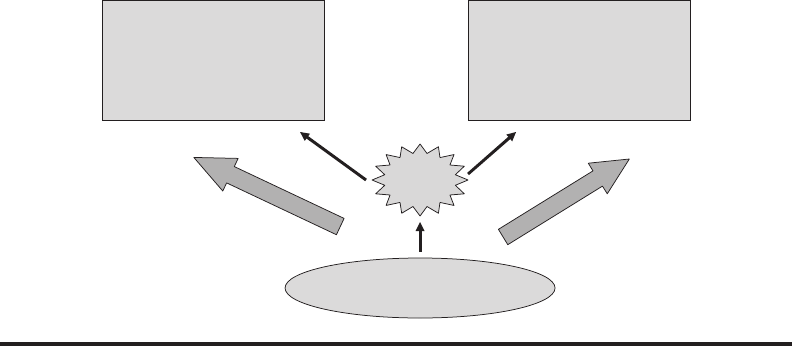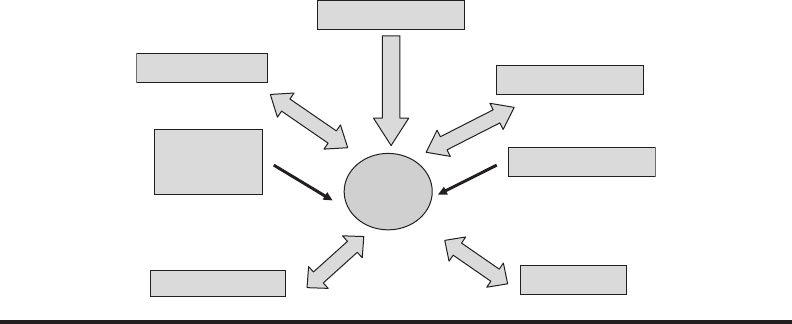
62 ◾ The Guide to Entrepreneurship: How to Create Wealth for Your Company
fast-paced technical and economic change, since we are all pre-programmed
to resist change. This is illustrated in Figure4.5.
◾ Transformational leadership introduces widespread change to an
organization.
◾ Invitational leadership strives to build relationships and a general sense
of belonging.
◾ Transactional leadership focuses on management, efciency, rules, and
regulations.
Under an autocratic style, the leader makes all decisions without staff
consultation or input, whereas the democratic leader encourages consen-
sus and majority rule. The paternalistic style fosters a “parental gure” who
forgives the transgressions of the staff. Finally, the laissez-faire (French: “let
it be”) leader allows decisions to be made by everyone, relying on the ability
and goodwill of the entire senior staff.
4.2.3 Leadership Is Situational
“Leadership is a journey. Greatness is its destination.”
Leaders nd that every senior employee (“follower”) requires a different
style of leadership, depending on the person’s individual development level
Style
* Autocratic
* Democratic
* Paternalistic
* Laissez-Faire
e Centrality of Leadership
Leadership types
eory
* Transformational
* Invitational
* Transactional
Change
Figure 4.5 The centrality of leadership—Leaders are the change agents, overcoming
organizational resistance.

The Entrepreneurial Environment ◾ 63
(“maturity”). Thus, leadership is situational. To address this issue, Hersey and
Blanchard
2
proposed that leaders adapt their style to a follower develop-
ment style (or maturity), based on the follower’s readiness and willingness
to perform required tasks (i.e., competence and motivation).
3
Known as the
Situational Leadership Model
©
(SLM), SLM is most effective when a leader:
(1) engages in two-way communication with a follower and asks the fol-
lower for input; (2) listens and provides support and encouragement to the
follower; (3) involves the follower in decision-making in order to facilitate
problem solving; and (4) encourages and promotes self-reliance in the fol-
lower’s behavior.
Each of four leadership styles (S1 to S4) aligns with a development level
(D1 to D4) of a follower. The leadership styles differ in focusing on directing
activities vs. emphasizing the leader-follower relationship. This is summa-
rized in Tables4.3 and 4.4.
Visually, SLM can be summarized in Figure4.6.
4
To summarize, the SLM theory states that successful leaders must adapt
their leadership style to situational needs. Effective leaders should know that
there is not a one-size-ts-all way to manage people, but instead should
adapt their styles according to the development levels of the people they lead.
Table4.3 The Four Situational Leadership Styles (in response to follower
development level)
S1: Telling/Directing
High task focus, low relationship focus
S2: Selling/Coaching
High task focus, high relationship focus
S3: Participating/Supporting
Low task focus, high relationship focus
(Follower lead)
S4: Delegating/Observing
Low task focus, low relationship focus
(Follower lead)
Table4.4 The Four Development Levels of Followers
D1: Low competence, low commitment/
unable and unwilling or insecure
D2: Some competence, variable
commitment/unable but willing or
motivated
D3: High competence, variable
commitment/able but unwilling or
insecure
D4: High competence, high
commitment/able and willing or
motivated

64 ◾ The Guide to Entrepreneurship: How to Create Wealth for Your Company
4.3 Establishing Your Founder Team
The founder team consists of key personnel and advisers who established
the startup organization. Frequently, the team is put together by more than
one individual, although typically not all team members have the same
amount of initial ownership (founder’s shares).
Your business’s DNA, including organizational structure, culture, power and
inuence, and business strategy and tactics, will be inuenced in no small
part by the characteristics of your team. You will need to decide whether the
members of your founding team are heterogeneous, that is, diverse, or homo-
geneous, that is, similar to one another, in their abilities and experiences.
The founder with a controlling share majority might ask, “Why do I need
to build a great team?” The answer is because lenders and investors prefer
an “A” team with a “B” product to a “B” team with an “A” product. Table4.5
summarizes the most important considerations when building a team.
4.3.1 Elements of Skilled Teams
Skilled teams bring credibility and stability to the startup. The founder will
quickly nd that his or her area of expertise is not sufcient to ensure busi-
ness success. Ironically, the founder starts as an expert (Expert = someone
Coaching
Delegating
Supporting
Directing
S4 S1
S3 S1
Supportive Behavior
Directive Behavior
Situational Leadership
Adapted from Hersey and Blanchard
Figure 4.6 Situational leadership—Leaders adapt their style according to the specic
situational needs encountered.

The Entrepreneurial Environment ◾ 65
who knows more and more about less and less) but later must become the
great “generalist.”
The skilled team brings access to all areas of business expertise, includ-
ing marketing, sales, manufacturing, accounting, and nance. Startups sur-
vive only by standing on the shoulders of many people, especially those
with collective experience in a multitude of disciplines. A team provides
greater opportunities to network, that is, build and maintain relationships
with people whose interests are similar or who can bring strategic advan-
tages to a rm.
6
This is illustrated in Figure4.7.
4.3.2 Establishing Your Board of Directors
“Quality, not quantity.”
Organizing a venture as a corporation requires constituting a board of
directors (BOD), a slate of individuals elected by a corporation to oversee
the governance of the entity. Corporate governance involves regulatory and
market mechanisms, relationships between a company’s management and
its board, shareholders and other stakeholders, roles and responsibilities of
senior individuals, and the goals that the corporation aims to achieve.
7
The
best boards do more than govern; they add value to your rm.
Table4.5 Characteristics of Founder Teams
5
• Founder has: (a) higher education credentials, (b) prior successful
entrepreneurial experience, (c) recognized expertise in a relevant technical
area, (d) professional contacts, and (e) “sweat equity” in the rm.
• A team brings a combination of talents, resources, and experience unmatched
by any single individual.
• Frequently, the entire team does not come together at once. Instead, it is built
as the new rm can afford to hire additional talent. At rst, the rm may rely on
non-paid “volunteers” willing the help get the organization “off the ground.”
• The team also involves more than insiders. Most startup teams consist of
boards of directors, boards of advisers, and other professionals on whom they
rely for direction and advice.
• New ventures have a high propensity to fail, in part, due to what researchers
call the “liability of newness.” Startups often falter because the people who
start rms cannot adjust quickly enough to their new roles and the rm lacks a
“track record” with investors, buyers, and suppliers.

66 ◾ The Guide to Entrepreneurship: How to Create Wealth for Your Company
In addition to fullling traditional roles of setting and monitoring imple-
mentation of business strategy, boards increasingly provide greater contri-
butions in operations, succession planning, executive compensation, risk
management, tactical decision-making, marketing strategies, etc.
Startups should start with an odd number of directors (typically three
or ve) to prevent potential deadlock on contentious issues. Aside from
the founder, who usually serves as Board Chairman, there is a tendency to
evenly split between inside directors (persons who work for the company)
and outside directors (directors who are independent and unafliated with
the rm) to ensure examination of issues from a balanced perspective.
The greatest benet of a BOD is its knowledge and understanding of
the industry. Good directors closely examine strategic plans, assumptions,
aggressiveness, and current market realities. Furthermore, the BOD should
collectively bring expertise in specialized areas such as nancial auditing,
fundraising, regulatory matters, and overseas operations.
The BOD has primary responsibility for overseeing and implementing the
company’s governance system. While responsibility for performing various
functions is delegated to specic departments, the BOD consolidates all the
activities under one coherent set of rules, as depicted in Figure4.8.
4.3.3 Selecting Your Board of Advisors
A Board of Advisors (BOA) is a panel of experts convened by the founder
to provide counsel, advice, and direction on an ongoing basis. Importantly,
The Founder Team Elements
Team
Board of Directors
Board of Advisors
Key Employees
Professionals
Bankers
Attorneys
Regulatory Affairs
Lenders, Investors
Management
Figure 4.7 The founder team elements—The stakeholders of the new enterprise.
..................Content has been hidden....................
You can't read the all page of ebook, please click here login for view all page.
